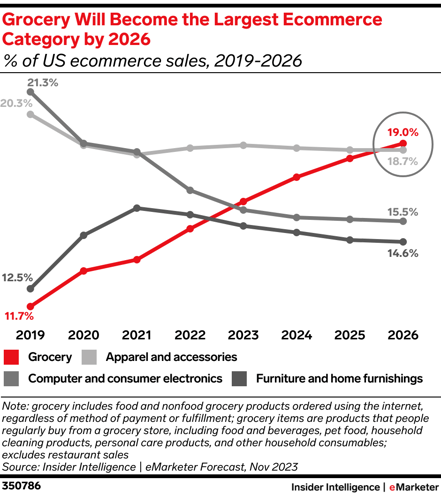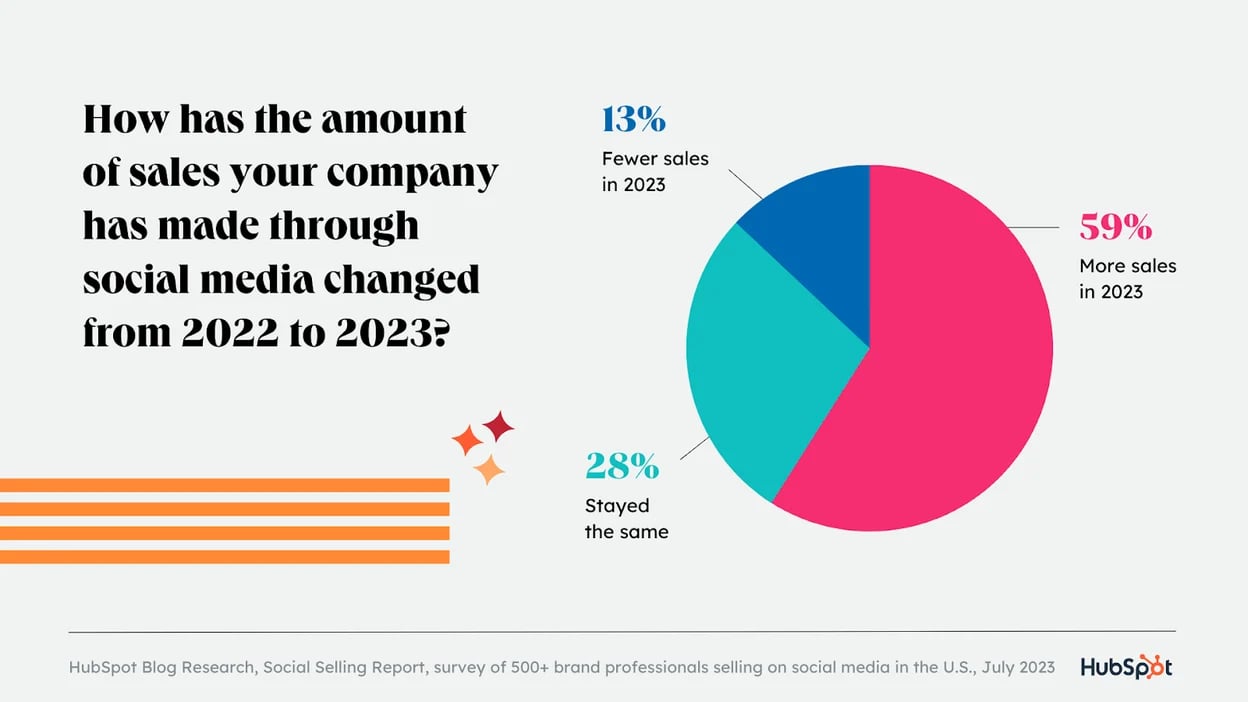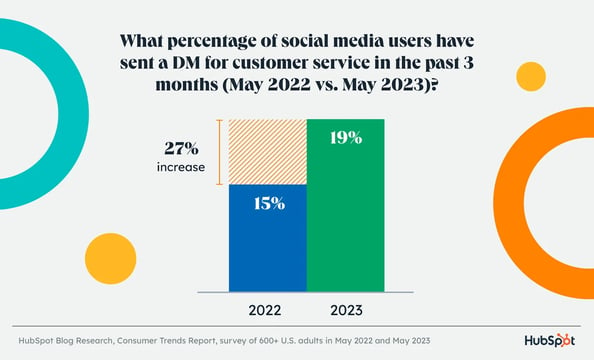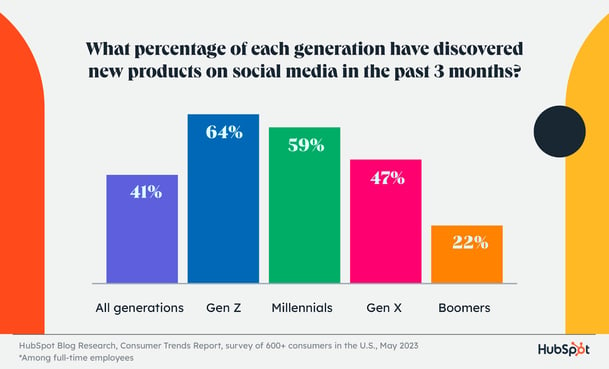Ecommerce is businesses selling products online, and people buying those products online.
Consumers and businesses alike are making more and more purchases online, and that’s only expected to increase, especially so on social media.
Below I’ve compiled a list of ecommerce statistics that will help you understand the potential impact of using the practice, as well as its growth potential throughout 2024 and beyond.
Table of Contents
- General Ecommerce Statistics
- Social Media Ecommerce Statistics
- Ecommerce Growth Statistics
- Consumer Behavior and Demographics Ecommerce Statistics
- B2B Ecommerce Statistics
- B2C Ecommerce Statistics
- Mobile Ecommerce Statistics
General Ecommerce Statistics
-
The average number of products bought per online order is 4.95. (Statista, 2023)
-
The global conversion rate of online shoppers is 1.9%. (Statista, 2023)
-
High-performing retail businesses are more likely to invest a given amount of their sales in digital and ecommerce. (Boston Consulting Group, 2023)
-
A majority of social media marketers (68%) use social media to drive traffic to products on its own website. (HubSpot, 2024)
-
eMarketer predicts that Grocery will become the largest ecommerce category in the U.S. by 2026. (eMarketer, 2024)

Image Source -
There was a 20% increase in consumers shifting to ecommerce channels in 2020. (McKinsey, 2023)The average cart abandonment rate is 70.19%. (Baymard, 2023)
-
Amazon is the biggest e-commerce company worldwide with a 1.34 trillion USD market cap. (Statista, 2023)
-
Free delivery is the main reason 45% of shoppers head online. (Data Reportal, 2023)
-
Most marketers say they have an employee responsible for managing social commerce. (HubSpot, 2024)
Social Media Ecommerce Statistics
-
87% of sellers say social selling has been effective for their business this year. (HubSpot, 2023)
-
59% of social sellers say their company is making more sales through social media this year than last year. (HubSpot, 2023)

Image Source -
High performing salespeople are 12% more likely to use social media when selling. (HubSpot, 2024)
-
More than half of social media marketers use social media to sell products directly within social media apps. (HubSpot, 2024)
-
50% of marketers plan to increase their investment in selling products directly in social media apps in 2024. (HubSpot, 2024)
-
Facebook, Instagram, and YouTube are the platforms social media marketers most commonly use for social selling. (HubSpot, 2024)
-
Instagram, TikTok, and Facebook offer the highest ROI for social selling. (HubSpot, 2024)
-
Social media is 3rd place in terms of channels where consumers are most receptive to advertising. (Integral Ad Science, 2024)
-
Social media marketers who sell products directly through social media apps say Facebook and YouTube have the highest ROI. (HubSpot, 2024)
Ecommerce Growth Statistics
-
Retail ecommerce sales are projected to reach more than eight trillion dollars by 2027. (Statista, 2023)
-
84% of social media marketers predict that, in 2024, consumers will buy products from brands directly in social media apps more than third-party websites and brand websites. (HubSpot, 2024)
-
Gartner predicts that 80% of B2B sales interactions will occur on digital channels by 2025. (Gartner, 2020)
-
eMarketer predicts that global retail media ad spend will reach $140 billion this year, which makes up 20.3% of all digital ad spend. (eMarketer, 2023)
-
The revenue in the US ecommerce market is forecasted to increase by 475 billion USD between 2024 and 2028. (Statista, 2023)
Consumer Behavior and Demographic Ecommerce Statistics
-
19% of consumers have reached out to customer service via DMs in the past 3 months, up 45% from 2022. (HubSpot, 2023)

Image Source -
A majority of consumers (82%) say they’re satisfied with their most recent social shopping experience. (HubSpot, 2023)
-
Adults aged 18 to 24 make up the largest share of ecommerce shoppers in the U.S. (Statista, 2023)
-
China has the highest number of consumers shopping on social networks. (Statista, 2023)
-
The total revenue of online retail in Asian countries totaled 1.7 trillion USD in 2023. (Statista, 2023)
-
The most common reason for cart abandonment among consumers is extra costs for things like shipping and taxes. Needing to create an account is the 2nd. (Forbes, 2023)
-
Gen Z, Millennials, and Gen X prefer finding products on social media over any other channel. (HubSpot, 2023)
 Image Source
Image Source -
Just 47% of social media users feel comfortable buying through social media apps. (HubSpot, 2023)
-
42% of consumers trust social media platforms with their personal card information. (HubSpot, 2023)
-
Facebook wins among social media users when it comes to social media shopping. It’s the most popular app for in-app purchases, they say it offers the best in-app shopping experience, and it’s the most trusted. (HubSpot, 2023)
-
TikTok is the least trusted platform among consumers for in-app shopping. (HubSpot, 2023)
-
A majority of consumers only somewhat agree that the products they buy directly on social media will come as described/depicted. (HubSpot, 2023)
-
The main concern consumers have about buying products directly within social media platforms is that the sellers aren’t legitimate companies/are a scam. (HubSpot, 2023)
B2B Ecommerce Statistics
-
79% of B2B buyers say they prefer to place repeat orders online. (Sana Commerce, 2023)
-
The main hurdle B2B buyers face with online purchasing is lack of accurate information on delivery times. (Sana Commerce, 2023)
-
65% of B2B companies across all industries offer ecommerce capabilities. (McKinsey, 2023)
-
80% of B2B companies say they hold their ecommerce channel to the same or higher standard as other channels. (McKinsey, 2023)
-
More than 1/3 of B2B buyers say they’re willing to spend $500,000 or more on digital channels, and 15% say they’re comfortable making purchases of more than $1 million online. (McKinsey, 2023)
B2C Ecommerce Statistics
-
Global B2C ecommerce revenue is projected to grow to 5.5 trillion USD by 2027. (International Trade Administration, 2024)
-
The most popular B2C e-commerce segments are consumer electronics, fashion, and furniture. (International Trade Administration, 2024)
Mobile Ecommerce Statistics
-
Smartphones account for 66% of online orders. (Statista, 2023)
-
Mobile retail e-commerce sales in the U.S. are expected to reach more than 560 billion by the end of 2024. (Statista, 2023)
-
Mobile Retail ecommerce sales in the U.S. will exceed 450 billion USD by the end of 2024. (Statista, 2024)
-
Apple Pay is the most used mobile payment format among U.S. consumers. (Statista, 2023)
-
60% of US adults believe that mobile shopping is a necessity for online shopping convenience. (eMarketer, 2022)
-
80% of consumers worldwide visit a retailer’s website from their smartphone while shopping in-store. (eMarketer, 2023)
-
Business Insider predicts that mobile commerce will account for 42.9% of e-commerce sales in 2024. (Business Insider, 2022)
from Marketing https://blog.hubspot.com/marketing/ecommerce-statistics
Ecommerce is businesses selling products online, and people buying those products online.
Consumers and businesses alike are making more and more purchases online, and that’s only expected to increase, especially so on social media.
Below I’ve compiled a list of ecommerce statistics that will help you understand the potential impact of using the practice, as well as its growth potential throughout 2024 and beyond.
Table of Contents
- General Ecommerce Statistics
- Social Media Ecommerce Statistics
- Ecommerce Growth Statistics
- Consumer Behavior and Demographics Ecommerce Statistics
- B2B Ecommerce Statistics
- B2C Ecommerce Statistics
- Mobile Ecommerce Statistics
General Ecommerce Statistics
-
The average number of products bought per online order is 4.95. (Statista, 2023)
-
The global conversion rate of online shoppers is 1.9%. (Statista, 2023)
-
High-performing retail businesses are more likely to invest a given amount of their sales in digital and ecommerce. (Boston Consulting Group, 2023)
-
A majority of social media marketers (68%) use social media to drive traffic to products on its own website. (HubSpot, 2024)
-
eMarketer predicts that Grocery will become the largest ecommerce category in the U.S. by 2026. (eMarketer, 2024)

Image Source -
There was a 20% increase in consumers shifting to ecommerce channels in 2020. (McKinsey, 2023)The average cart abandonment rate is 70.19%. (Baymard, 2023)
-
Amazon is the biggest e-commerce company worldwide with a 1.34 trillion USD market cap. (Statista, 2023)
-
Free delivery is the main reason 45% of shoppers head online. (Data Reportal, 2023)
-
Most marketers say they have an employee responsible for managing social commerce. (HubSpot, 2024)
Social Media Ecommerce Statistics
-
87% of sellers say social selling has been effective for their business this year. (HubSpot, 2023)
-
59% of social sellers say their company is making more sales through social media this year than last year. (HubSpot, 2023)

Image Source -
High performing salespeople are 12% more likely to use social media when selling. (HubSpot, 2024)
-
More than half of social media marketers use social media to sell products directly within social media apps. (HubSpot, 2024)
-
50% of marketers plan to increase their investment in selling products directly in social media apps in 2024. (HubSpot, 2024)
-
Facebook, Instagram, and YouTube are the platforms social media marketers most commonly use for social selling. (HubSpot, 2024)
-
Instagram, TikTok, and Facebook offer the highest ROI for social selling. (HubSpot, 2024)
-
Social media is 3rd place in terms of channels where consumers are most receptive to advertising. (Integral Ad Science, 2024)
-
Social media marketers who sell products directly through social media apps say Facebook and YouTube have the highest ROI. (HubSpot, 2024)
Ecommerce Growth Statistics
-
Retail ecommerce sales are projected to reach more than eight trillion dollars by 2027. (Statista, 2023)
-
84% of social media marketers predict that, in 2024, consumers will buy products from brands directly in social media apps more than third-party websites and brand websites. (HubSpot, 2024)
-
Gartner predicts that 80% of B2B sales interactions will occur on digital channels by 2025. (Gartner, 2020)
-
eMarketer predicts that global retail media ad spend will reach $140 billion this year, which makes up 20.3% of all digital ad spend. (eMarketer, 2023)
-
The revenue in the US ecommerce market is forecasted to increase by 475 billion USD between 2024 and 2028. (Statista, 2023)
Consumer Behavior and Demographic Ecommerce Statistics
-
19% of consumers have reached out to customer service via DMs in the past 3 months, up 45% from 2022. (HubSpot, 2023)

Image Source -
A majority of consumers (82%) say they’re satisfied with their most recent social shopping experience. (HubSpot, 2023)
-
Adults aged 18 to 24 make up the largest share of ecommerce shoppers in the U.S. (Statista, 2023)
-
China has the highest number of consumers shopping on social networks. (Statista, 2023)
-
The total revenue of online retail in Asian countries totaled 1.7 trillion USD in 2023. (Statista, 2023)
-
The most common reason for cart abandonment among consumers is extra costs for things like shipping and taxes. Needing to create an account is the 2nd. (Forbes, 2023)
-
Gen Z, Millennials, and Gen X prefer finding products on social media over any other channel. (HubSpot, 2023)
 Image Source
Image Source -
Just 47% of social media users feel comfortable buying through social media apps. (HubSpot, 2023)
-
42% of consumers trust social media platforms with their personal card information. (HubSpot, 2023)
-
Facebook wins among social media users when it comes to social media shopping. It’s the most popular app for in-app purchases, they say it offers the best in-app shopping experience, and it’s the most trusted. (HubSpot, 2023)
-
TikTok is the least trusted platform among consumers for in-app shopping. (HubSpot, 2023)
-
A majority of consumers only somewhat agree that the products they buy directly on social media will come as described/depicted. (HubSpot, 2023)
-
The main concern consumers have about buying products directly within social media platforms is that the sellers aren’t legitimate companies/are a scam. (HubSpot, 2023)
B2B Ecommerce Statistics
-
79% of B2B buyers say they prefer to place repeat orders online. (Sana Commerce, 2023)
-
The main hurdle B2B buyers face with online purchasing is lack of accurate information on delivery times. (Sana Commerce, 2023)
-
65% of B2B companies across all industries offer ecommerce capabilities. (McKinsey, 2023)
-
80% of B2B companies say they hold their ecommerce channel to the same or higher standard as other channels. (McKinsey, 2023)
-
More than 1/3 of B2B buyers say they’re willing to spend $500,000 or more on digital channels, and 15% say they’re comfortable making purchases of more than $1 million online. (McKinsey, 2023)
B2C Ecommerce Statistics
-
Global B2C ecommerce revenue is projected to grow to 5.5 trillion USD by 2027. (International Trade Administration, 2024)
-
The most popular B2C e-commerce segments are consumer electronics, fashion, and furniture. (International Trade Administration, 2024)
Mobile Ecommerce Statistics
-
Smartphones account for 66% of online orders. (Statista, 2023)
-
Mobile retail e-commerce sales in the U.S. are expected to reach more than 560 billion by the end of 2024. (Statista, 2023)
-
Mobile Retail ecommerce sales in the U.S. will exceed 450 billion USD by the end of 2024. (Statista, 2024)
-
Apple Pay is the most used mobile payment format among U.S. consumers. (Statista, 2023)
-
60% of US adults believe that mobile shopping is a necessity for online shopping convenience. (eMarketer, 2022)
-
80% of consumers worldwide visit a retailer’s website from their smartphone while shopping in-store. (eMarketer, 2023)
-
Business Insider predicts that mobile commerce will account for 42.9% of e-commerce sales in 2024. (Business Insider, 2022)
![Download Now: Free State of Marketing Report [Updated for 2024]](https://no-cache.hubspot.com/cta/default/53/b0f73a5e-16e4-41fd-9511-8564efc560a7.png)

No hay comentarios:
Publicar un comentario